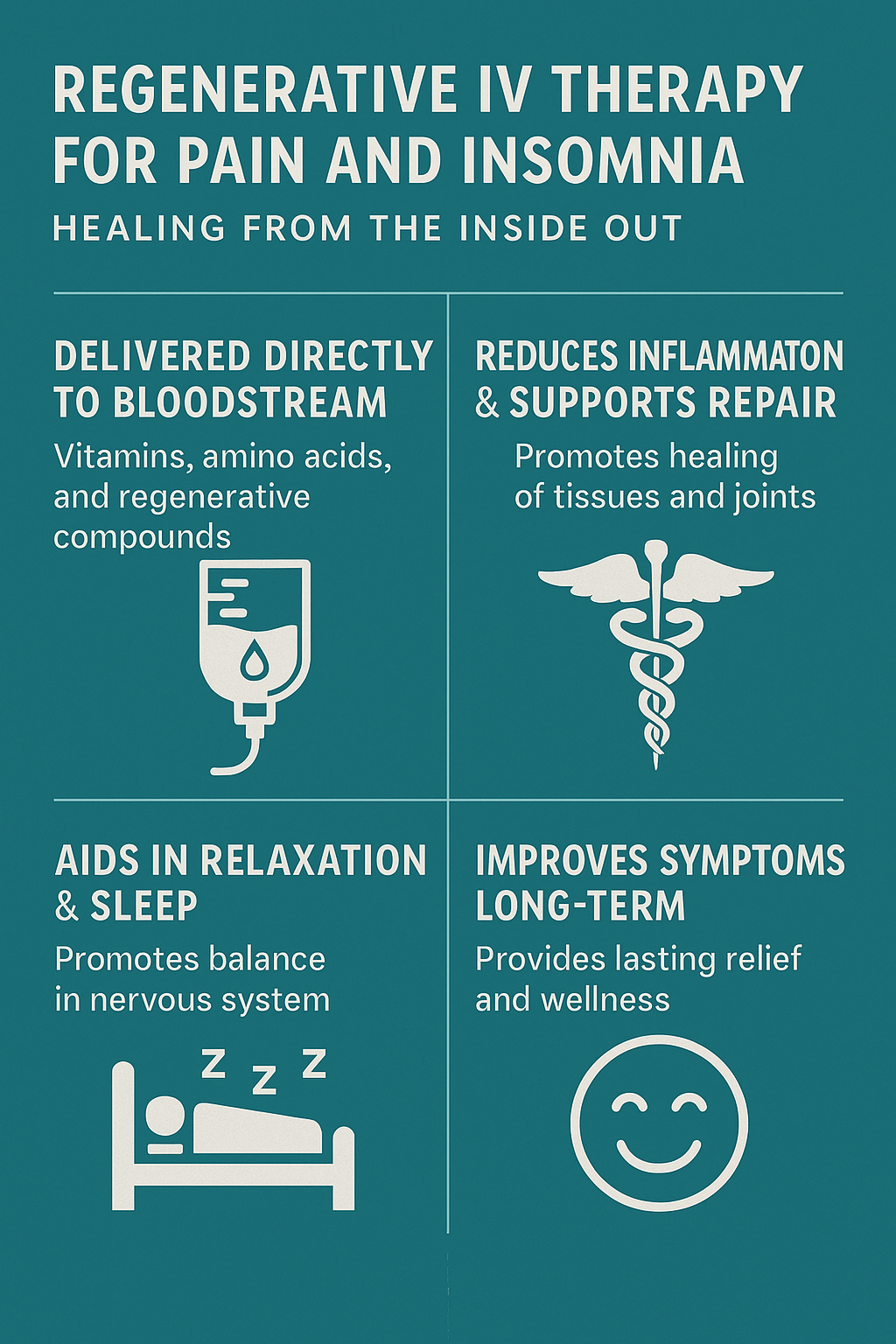Regenerative IV therapy is quickly gaining attention as an option for managing chronic pain and improving sleep. These two issues often go hand-in-hand. I’ve spent considerable time researching these treatments, speaking with individuals who use them, and reviewing the latest research findings. Here’s a closer look at what regenerative IV therapy is, how it’s being used for pain and sleep, and what you might want to know if you’re considering giving it a try.
What is Regenerative IV Therapy?
Regenerative IV therapy combines intravenous infusions with substances meant to help the body heal, recover, or function better. The blend may include vitamins, minerals, amino acids, antioxidants, and, sometimes, biological elements such as platelet-rich plasma or stem cell derivatives. The main idea is to deliver these nutrients directly into the bloodstream for faster, more noticeable effects than with pills or dietary changes alone.
The approach isn’t exactly new. IV drips have long been used for hydration, nutrition, and medication. What’s changed is the mix of ingredients and the focus on using IV therapy for issues like chronic pain and sleep disturbances. Most clinics offering these treatments cater to people living with persistent joint pain, muscle tension, headaches, fibromyalgia, and insomnia.
Understanding Chronic Pain and Sleep Problems
Chronic pain is pain that sticks around for weeks, months, or even years, long after an injury should have healed or even without a clear cause. Common triggers include arthritis, back injuries, neuropathy, and autoimmune conditions. Sleep issues, like trouble falling asleep, waking up frequently, or feeling tired despite a whole night in bed, are more common among folks with chronic pain. Studies show that poor sleep makes pain worse, and ongoing pain makes it harder to sleep. It’s a frustrating cycle for many.
Standard treatments for these conditions often begin with medication, physical therapy, or lifestyle modifications. Not everyone gets good results from these alone. That’s why many are seeking new options that may provide better relief without significant side effects or concerns about dependency.
How Regenerative IV Therapy Addresses Pain and Sleep
IV therapy for pain and sleep aims to tackle root issues such as inflammation, oxidative stress, nutritional deficiencies, and imbalances in neurotransmitters. Here’s how some common IV ingredients may help:
- Magnesium: Known for its muscle-relaxing and nerve-soothing properties. It can help alleviate both chronic pain and calm the nervous system, leading to improved sleep.
- Vitamin B complex: Supports nerve health, energy metabolism, and mood, all tied to pain levels and sleep quality.
- Vitamin C and Glutathione: Strong antioxidants that can lower inflammation, which plays a role in chronic pain and poor sleep patterns.
- Amino acids like glycine and taurine: Some of these have a mild sedative effect, encourage muscle recovery, and help the body calm down before bed.
Most regenerative IV protocols are customized to individual needs. Some clinics may also add supplements, such as melatonin or zinc, or small doses of certain medications, if sleep disturbance is a greater concern than pain.
The IV Therapy Process: What to Expect
Getting an IV drip typically begins with a discussion about your symptoms and health history. After determining your goals (for example, reducing pain, improving sleep, or both), the provider suggests a custom blend for your IV bag. The infusion typically lasts between 30 and 60 minutes. You’ll chill in a comfortable chair while the nutrients do their thing. Most people don’t feel much during the drip, though a cold sensation in the arm is normal and nothing to worry about.
People typically report feeling a boost within hours or the next day, but repeated sessions are often recommended for stubborn issues. Some use IV therapy as maintenance every month or two, while those with significant flare-ups might go weekly to start. It’s a flexible approach that can be tailored to your level of symptoms.
Why Some People Choose Regenerative IV Therapy
There are a few reasons people turn to these treatments over conventional options:
- Fewer side effects: Many want to avoid or reduce reliance on medications like opioids or sleeping pills because of unwanted effects or dependency concerns.
- Direct impact: IV therapy delivers nutrients directly into the bloodstream, bypassing digestive hurdles that can occur with oral vitamins when absorption is poor.
- Quick results: Some clients describe a rapid sense of relief, especially with fatigue or muscle soreness.
Stories from people I’ve spoken with include those who’ve struggled for years with migraines or back pain, finally getting some relief with a steady IV routine. Others report falling asleep faster and waking up less frequently during the night after a few sessions focused on nutrients for sleep support. Results depend on the person, but the appeal is clear for those who haven’t found relief elsewhere.
Potential Drawbacks and Limitations
It’s essential to understand that, while many find benefits, regenerative IV therapy isn’t a miracle cure. Research is still evolving, and results can vary significantly from person to person. There’s also the cost involved. Sessions can be expensive, especially since insurance typically doesn’t cover these treatments, and multiple sessions may be required for optimal benefit.
IV therapy can also come with minor risks like discomfort at the injection site, vein irritation, bruising, or an allergic reaction to some components. Serious complications are rare if the IV is set up by a licensed professional in a clean setting. Careful screening helps reduce the risk for anyone with kidney, heart, or fluid imbalance issues. If you’re ever in doubt about whether it’s safe for your situation, check in with your regular healthcare provider first.
Tips for Trying Regenerative IV Therapy
- See a licensed provider: Regardless of a clinic’s number of positive reviews, ensure your provider is a medical professional trained in IV therapy. Don’t be afraid to ask about credentials and experience.
- Review your health history: Some individuals, such as those with kidney problems or severe heart conditions, may require extra caution or a different approach altogether. Be honest about your health background.
- Start slowly: If you’re new to IV therapy, let your provider know so they can adjust the formula for your first visit and monitor your progress over the next day or two.
- Keep track of your results: Write down how you feel after each session, both physically and regarding your sleep, to notice what works best for you. Please pass this on at your next appointment so the treatment can be adjusted if needed.
Other Ways to Support Pain Relief and Sleep
Regenerative IV therapy tends to work more effectively when used as part of a comprehensive treatment plan. Here are some other moves worth considering if you’re dealing with pain or restless nights:
- Light exercise, such as gentle stretching, walking, or yoga, can help ease stiffness and improve sleep quality over time—even small amounts matter.
- Consistent sleep routines: Going to bed and waking up at the same time every day can significantly improve many people’s sleep cycles, making it easier to fall asleep and stay asleep throughout the night.
- Nutrition: Eating a balanced diet keeps you well-nourished with essential nutrients like magnesium, B vitamins, and antioxidants, which are often found in IV bags.
- Stress management: Options such as meditation, breathing exercises, and talking with a therapist can help lower body tension and make pain more manageable.
Real-World Stories and What the Research Says
Treatments are even more interesting when you connect the science to authentic experiences. Research on IV therapy for pain and sleep is still building. Some early studies and numerous anecdotes suggest that nutrient IVs may help reduce pain flare-ups, shorten muscle recovery time, and improve sleep quality, particularly when incorporated into a comprehensive wellness plan. Cases from both athletes and regular individuals support this story, as many report improvements in recovery and overall well-being after starting regular IV therapy alongside other lifestyle adjustments.
I’ve talked to people who describe progressive improvement over several weeks, sometimes even using fewer painkillers as time goes on. Still, results can vary significantly from person to person. Some feel a big difference, while others don’t notice much change after a few sessions. Keeping an open mind while also tracking your progress is key if you decide to try it out.
For a closer look at clinical evidence, the American Academy of Pain Medicine and the National Sleep Foundation both offer resources on the benefits and limitations of alternative treatments, including IV options. You can learn more about these approaches at painmed.org and thenf.org. Keep in mind that, like many wellness therapies, ongoing research is essential for drawing solid conclusions.
Frequently Asked Questions
Question: How soon will I feel relief from regenerative IV therapy?
Answer: Some people notice a difference later that day or by the next morning, mainly if the IV includes calming or anti-inflammatory ingredients. For ongoing pain or major sleep issues, several sessions might be needed before you notice a steady effect.
Question: Is regenerative IV therapy safe for everyone?
Answer: Most healthy adults can try it, but it’s always smart to check in with your doctor if you have kidney, liver, or heart disease or take medications that affect your fluids or electrolytes.
Question: Can IV therapy fully replace pain medication or sleep aids?
Answer: Not for everyone. IV therapy is often used as part of a wider plan alongside physical therapy, meds, or changes in routine. Some individuals may be able to reduce their usual medication dosage, but it’s advisable to discuss any changes with your healthcare provider first.
Final Thoughts
Regenerative IV therapy gives people looking for pain relief and better sleep another route to try. Especially if traditional methods haven’t worked out, it can be a worthwhile addition. It’s a relatively new area that’s still gaining clinical support, so careful research helps buyers make informed decisions. Chatting with your healthcare provider is the best way to determine if this path is right for you.
Keeping an open mind and a skeptical eye usually works best when trying something new in the realm of wellness. If you decide to try regenerative IV therapy, tracking your progress over time can help you maximize the benefits of your investment. Don’t forget, addressing chronic pain and sleep takes patience and may require more than one solution working together. Combining therapies, adjusting your lifestyle, and listening to your body will often yield the best results in the long run.
Video: How IV Therapy Fights Pain and Insomnia Fast

